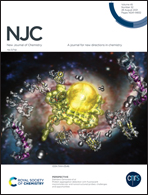Biodegradation of anionic polyacrylamide mediated by laccase and amidase: docking, virtual mutation based on affinity and DFT study†
Abstract
Biodegradation of anionic polyacrylamide (HPAM) by key enzymes, such as amidase and laccase, has been reported. However, the interaction details between HPAM and enzymes are still unclear. Here, docking was performed to demonstrate their binding modes and interactions. Then, alanine (ALA) scanning and saturated mutation were performed by virtual mutation based on affinity. Finally, the bioactivities of substrates were evaluated with frontier orbitals. The docking results showed that Rh Amidase-HPAM-2 was the most stable, mainly due to more hydrophobic interactions and hydrogen bonds, while a strong salt bridge and two hydrogen bonds were found to be the main reason for B. subtilis laccase-HPAM-3 being the most stable. It was confirmed by virtual mutations that PHE146, ILE450, LYS96 and GLY193 were the key amino acid residues of Rh Amidase degrading HPAM-2, and the mutant D191A could strengthen their affinity. It was also confirmed that TYR118, TYR133, ARG487 and LYS135 were the key amino acid residues of B. subtilis laccase degrading HPAM-3. The frontier orbital analysis indicated that the bioactivity of HPAM was higher than that of PAA, and the macromolecular chain was difficult to be degraded. A potential mechanism for HPAM degradation was proposed. The amide side chain of HPAM was hydrolyzed by Rh Amidase into carboxyl, and NH4+ was used as a nitrogen source, while the carbon skeleton of HPAM was broken by B. subtilis laccase as a carbon source for microbial growth. These findings provide a theoretical reference for designing highly efficient enzymes.



 Please wait while we load your content...
Please wait while we load your content...